The Google Nexus 9 Review
by Joshua Ho & Ryan Smith on February 4, 2015 8:00 AM EST- Posted in
- Tablets
- HTC
- Project Denver
- Android
- Mobile
- NVIDIA
- Nexus 9
- Lollipop
- Android 5.0
Display
For those that are uninitiated to the world of displays, a display seems relatively simple. After all, it just needs to have high resolution, pretty colors, high brightness, and high contrast. However, there’s a great deal of complexity to this issue. Even excluding the actual structure of a display, the characteristics of a display can strongly affect perception. Poor display calibration, low brightness, high reflectance, and low contrast can all affect the experience. In addition, something as simple as subpixel arrangement and the thin-film transistor design can have significant impacts on viewing angles and battery life.
In order to test these things, we use SpectraCal’s CalMAN 5 Ultimate and X-Rite’s i1pro2 spectrophotometer to ensure accuracy in our testing, in conjunction with subjective testing to get a good idea of overall display performance. As always, we target sRGB gamut and 2.2 gamma as these are the industry standard. While there are many arguments for larger gamuts and different gamma curves, the goal of our display calibration testing is to make sure that a display will be reasonably accurate in its reproduction of content as an artist intended. Without this calibration, videos, photos, and other content can appear "off".
While we still don’t have an accurate reflectance test, I spent a great deal of time wondering why the display on the Nexus 9 seemed to have more distracting glare than most. This was strange to me as the display was obviously laminated with no perceivable viewing angle degradation that comes with non-laminated displays. It seems that whatever material HTC has used to laminate the display isn’t quite ideal in this case, as at some point in the display stack there’s an obvious secondary reflection. This is an issue relating to a lower index of refraction, so it’s likely that some other characteristic was valued over reflectance.
Other than this, the only other immediately noticeable flaw is the display’s backlight bleed. To me, it’s quite obvious that the display gets lighter at the edges much like what I’ve seen on the Nexus 5. It seems that this is related to the backlight configuration, although given the high brightness of the panel I'm not sure that this can be avoided.
Before we get into the objective testing, I also wanted to mention that this display has “dual-domain pixels” similar to the iPad Air 2 and iPhone 6. The level of angling seems to be much more significant though, which seems to make the purple blacks much more obvious, but outside of this shift in black point it’s almost impossible to see shifts in color with changes in viewing angle. The microscope photo combined with some casual examination under sunlight suggests that the digitizer has been integrated into the display for improved clarity. The resolution is also quite high for a tablet, and while I can obviously pick out aliasing when closely examining the display, at a normal viewing distance I don’t really see any of these problems.
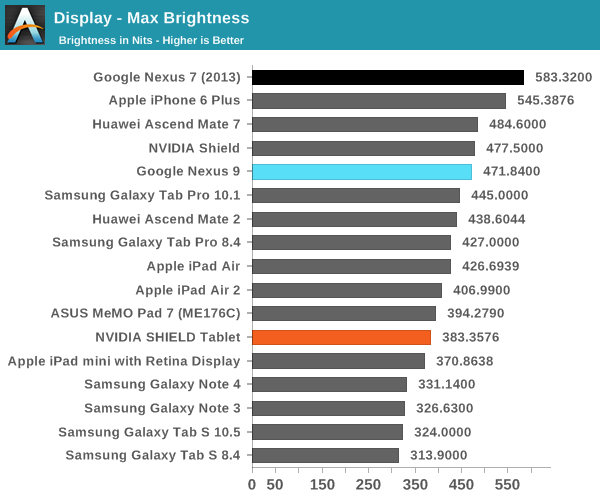
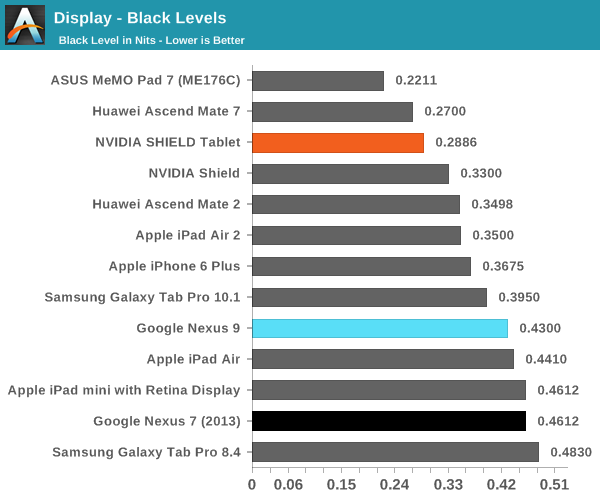
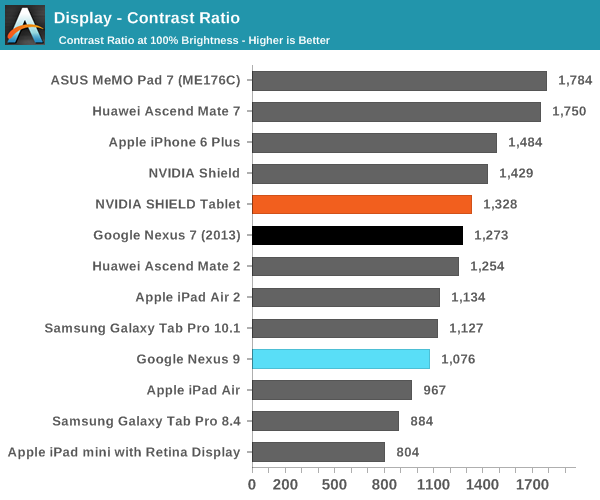
The brightness of the Nexus 9's display ends up higher than what we see with the iPad Air 2. Contrast is approximately equal to what we see in the iPad Air 2, which is good but definitely not the perfect inky blacks that one might be used to from AMOLED.
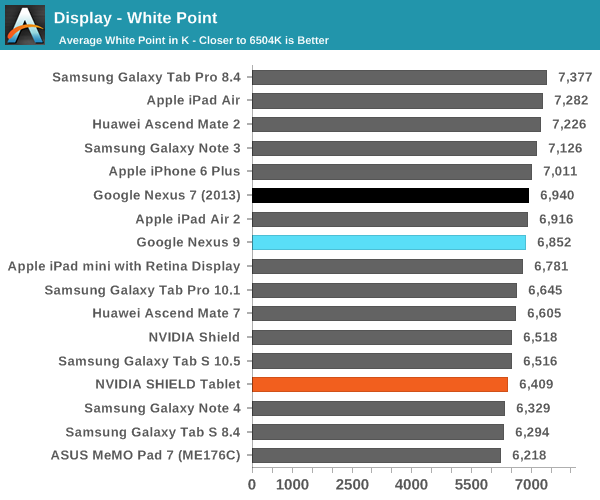
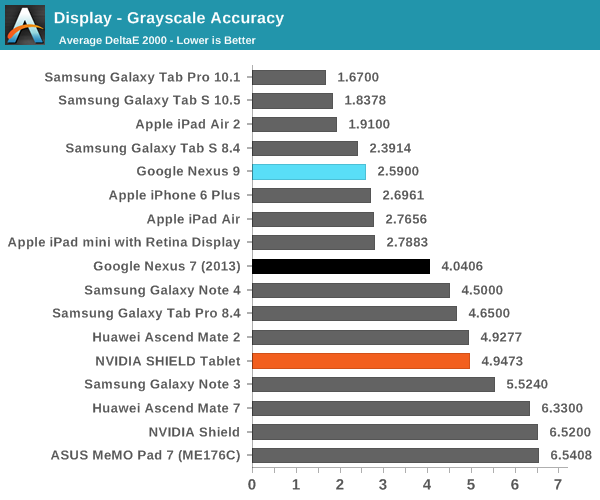
The next aspect of our display test suite is the grayscale test, which looks at the color balance and brightness of various shades of grayscale from black to white. Here, the Nexus 9 really does a great job across the board. If I were to nitpick, there is a bit of extra blue in the display but it’s really nothing worth talking about. Google does seem to consistently favor a lower contrast look when the gamma curve is dead on the mark, but on average it’s close enough to a power 2.2 curve that it doesn’t make a difference when viewing the display.
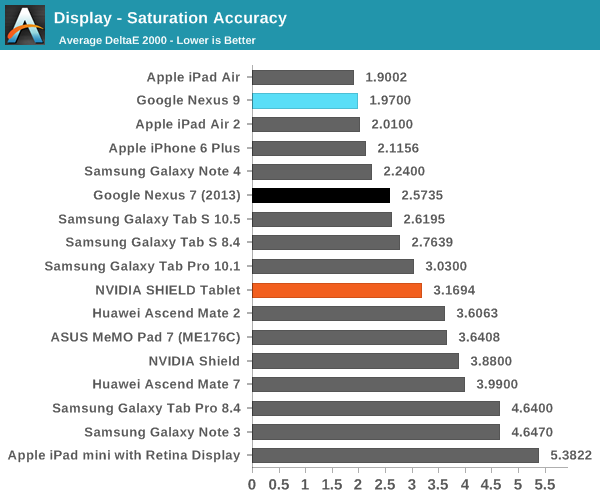
While grayscale is important, colors are really the hardest part to get right in a display. Here, the Nexus 9 does an amazing job in our saturation test. I really don’t have anything else to say here as pretty much everything is on the mark. At this point, it’s pretty clear that most Nexus devices have a strong focus on display quality, and the Nexus 9 is no exception.
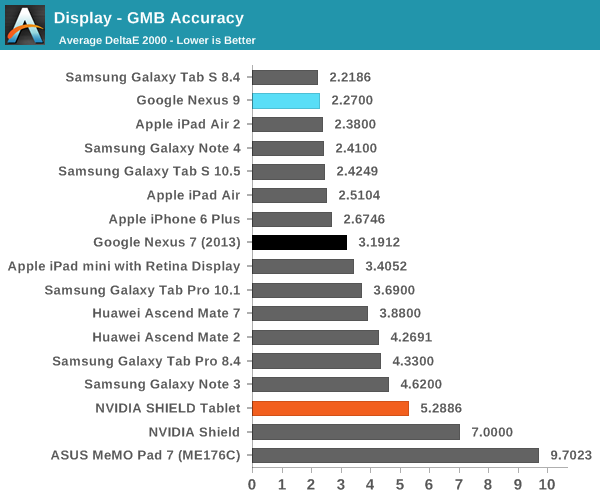
Finally, the Gretag MacBeth test shows that the Nexus 9 is quite accurate with color even outside of the basic primary and secondary colors. There shouldn’t be any issues with viewing content that has high requirements for color accuracy. Overall, the Nexus 9 display is great with only two real issues of note, namely the reflectance issue and the backlight bleed. While neither are deal-breakers, fixing these issues would make this display fall under a short list of the best mobile displays I’ve seen all year. For now, it sits just shy of that list. I definitely have to applaud Google in this case as they haven’t fallen into the trap of wider gamuts, bluer white points, dynamic contrast, and other “features” for the sake of showroom appeal.


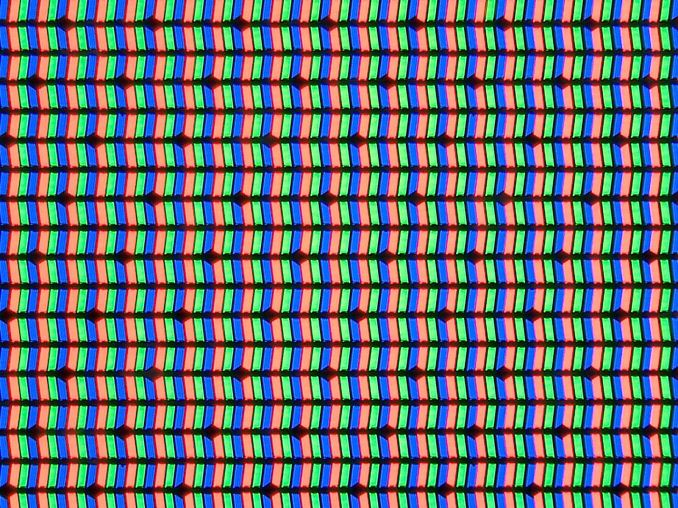

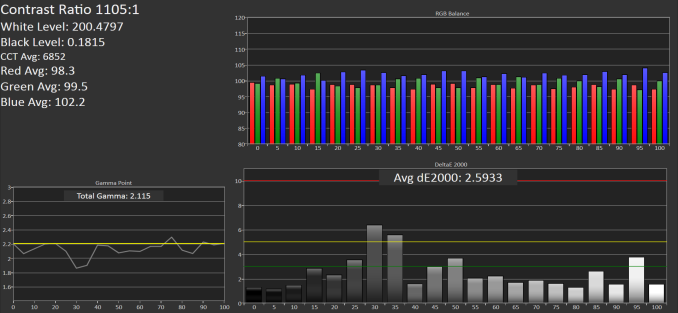
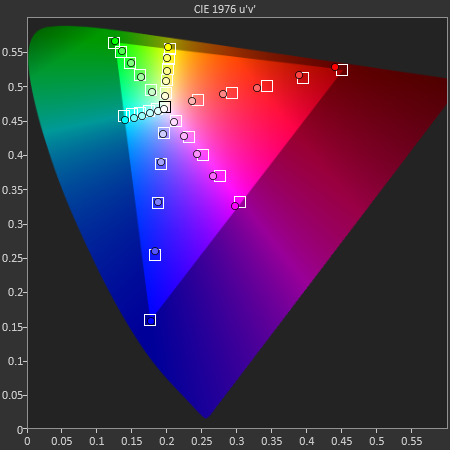
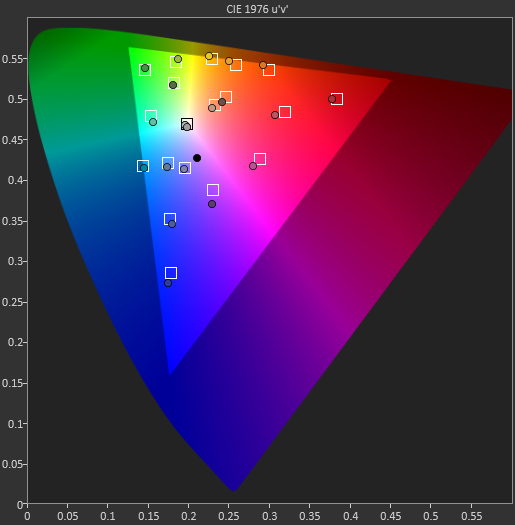








169 Comments
View All Comments
mkygod - Saturday, February 7, 2015 - link
I think so to. The 3:2 ratio is one of the things that Microsoft has gotten right with their Surface Pro devices. It's the perfect compromise IMOUtilityMax - Sunday, February 8, 2015 - link
I am a little perplexed by this comment. A typical user will be on the web 90% of time. Not only the web browser does not need to be natively designed or optimized for any screen ratio, but it also will be more usable on a 4:3 screen. So will the productivity apps. The only disappointment for me on the 4:3 screen would be with watching the widescreen videos or TV shows. Moreover, there is quite a bit of evidence than a lot of the next generation tablets will be 4:3. Samsung's next flagship tablet supposedly will be 4:3.gtrenchev - Wednesday, February 4, 2015 - link
Anandtech is becoming more and more boring last year. Sparse on reviews, short on tech comments, lacking on depth and enthusiasm. I can see Anandtech has become a just job for you guys, not the passion it was for Anand :-) And yes, his absence is definitely noticeable.George
Ian Cutress - Wednesday, February 4, 2015 - link
Was the Denver deep-dive not sufficient enough? Always welcome for comments.As for timing, see Ryan's comment above.
We've actually had a very good quarter content wise, with a full review on the front page at least four out of every five weekdays if not every weekday.
milkod2001 - Wednesday, February 4, 2015 - link
Why not to post on your forum some sort of suggestion box/poll where all could say what should get reviewed first so some folks won't cry where is the review of their favorite toy :) ?Impulses - Wednesday, February 4, 2015 - link
Because they'll still cry regardless, and they can't possibly work entirely based on readers' whim, doesn't make sense logistically or nor editorially... Readers might vote on five things ahead of the rest which all fall on the same writer's lap, they won't all get reviewed before the rest, or readers might not be privy to new hardware because of NDAs or cases where Anandtech can't source something for review.tuxRoller - Thursday, February 5, 2015 - link
While I enjoyed the review, I would've loved to have seen the kind of code driven analysis that was done with Swift.In particular, how long does it take for dco to kick in. What is the IPC for code that NEVER gets optimized, and conversely, what is the IPC for embarrassingly instruction-wise parallel code? Since it's relying on ram to store the uops, how long does the code need to run before it breaks even with the arm decoder? Etc.
victorson - Wednesday, February 4, 2015 - link
Are you guys kidding? Better late than never, but heck.. this is freaking late.abufrejoval - Wednesday, February 4, 2015 - link
Thanks for making it worth the wait!The in-depth analysis of Denver is uniquely Anandtech, because you can't get that anywhere else.
And while Charly D. is very entertaining, the paywall is a bit of an impediment and I quite like again the Anand touch of trying to be as fair as possible.
I was and remain a bit worried that there seems to be no other platform for Denver, which typically signals a deeper flaw with an SoC in the tablet and phone space.
While I'm somewhat less worried now, that Denver might be acceptable as a SoC, the current Nexus generation is no longer attractive at these prices, even less with the way the €/$ is evolving.
Taneli - Wednesday, February 4, 2015 - link
eDRAM cache à la Crystalwell would be interesting in a future Denver chip.